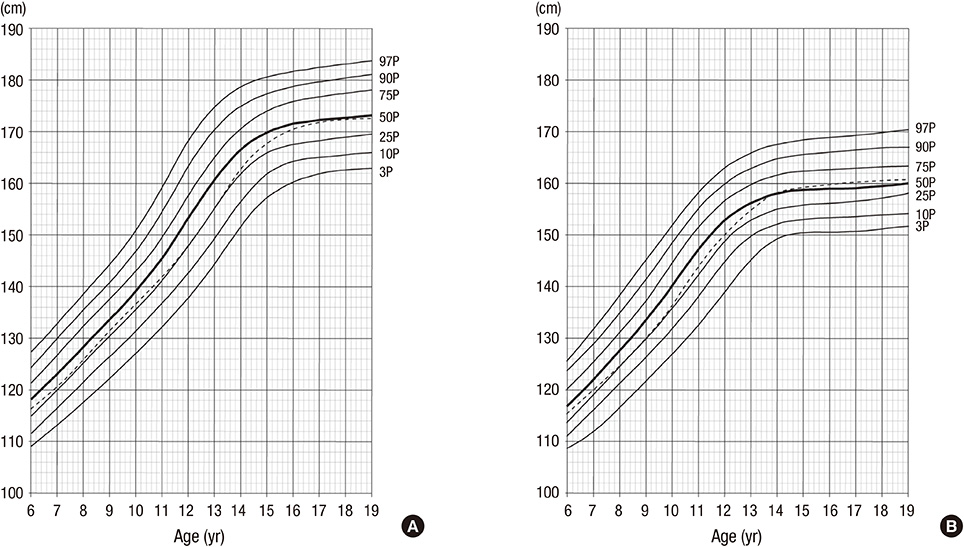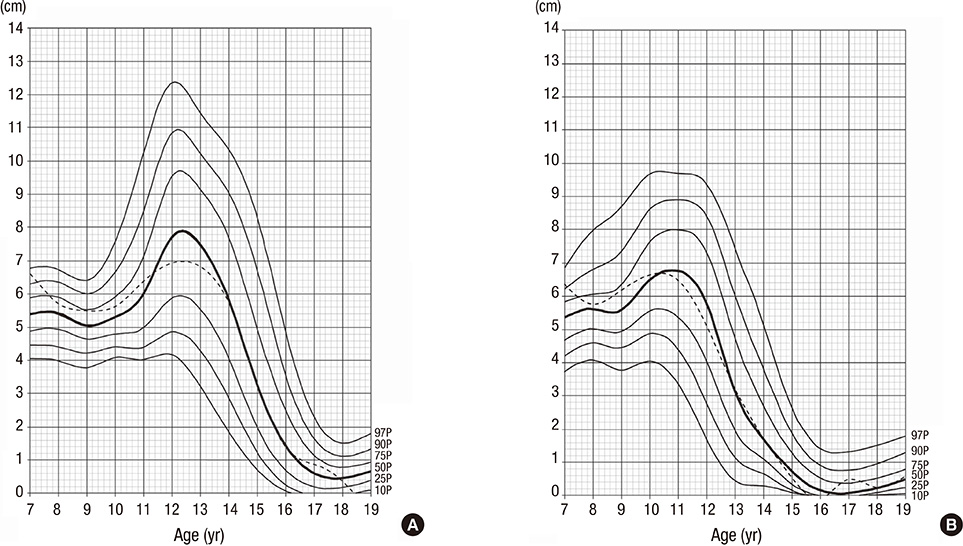J Korean Med Sci.
2013 Oct;28(10):1512-1517. 10.3346/jkms.2013.28.10.1512.
Longitudinal Standards for Height and Height Velocity in Korean Children and Adolescents: the Kangwha Cohort Study
- Affiliations
-
- 1Department of Pediatrics, Endocrine Research Institute, Yonsei University College of Medicine, Seoul, Korea. kimho@yuhs.ac
- 2Department of Preventive Medicine, Yonsei University College of Medicine, Seoul, Korea.
- 3Biostatistics Collaboration Unit, Yonsei University College of Medicine, Seoul, Korea.
- 4Sowha Children's Hospital, Seoul, Korea.
- KMID: 1777690
- DOI: http://doi.org/10.3346/jkms.2013.28.10.1512
Abstract
- Longitudinal standards for height and height velocity are essential to monitor for appropriate linear growth. We aimed to construct standards in Korean children and adolescents through the population-based longitudinal Kangwha study. Our study was a part of a community-based prospective cohort study from 1986 to 1999 with 800 school children. Height and height velocity were recorded annually from age 6 until final height. Results were compared with cross-sectional data from the 2007 Korean National Growth Charts. Final height was 173.5 cm in boys and 160.5 cm in girls. Although final height was similar between longitudinal and cross-sectional standards, the mean height for age was higher in the longitudinal standard by 1-4 cm from age 6 until the completion of puberty. Using the longitudinal standard, age at peak height velocity (PHV) was 12 in boys and 10 in girls; height velocity at PHV was 8.62 cm/yr in boys and 7.07 cm/yr in girls. The mean height velocity was less than 1 cm/yr at age 17 in boys and 15 in girls. Thus, we have presented the first report of longitudinal standards for height and height velocity in Korean children and adolescents by analyzing longitudinal data from the Kangwha cohort.
MeSH Terms
Figure
Cited by 2 articles
-
Age of menarche and near adult height after long-term gonadotropin-releasing hormone agonist treatment in girls with central precocious puberty
Joon-Woo Baek, Hyo-Kyoung Nam, Dahee Jin, Yeon Joung Oh, Young-Jun Rhie, Kee-Hyoung Lee
Ann Pediatr Endocrinol Metab. 2014;19(1):27-31. doi: 10.6065/apem.2014.19.1.27.Changes in anthropometric indices among Korean school students based on the 2010 and 2018 Korea School Health Examination Surveys
Moon Young Seo, Shin-Hye Kim, Mi Jung Park
Ann Pediatr Endocrinol Metab. 2021;26(1):38-45. doi: 10.6065/apem.2040100.050.
Reference
-
1. Tanner JM. Normal growth and techniques of growth assessment. Clin Endocrinol Metab. 1986; 15:411–451.2. Cole TJ. Growth charts for both cross-sectional and longitudinal data. Stat Med. 1994; 13:2477–2492.3. Ahmed ML, Allen AD, Sharma A, Macfarlane JA, Dunger DB. Evaluation of a district growth screening programme: the Oxford Growth Study. Arch Dis Child. 1993; 69:361–365.4. Tanner JM, Whitehouse RH. Clinical longitudinal standards for height, weight, height velocity, weight velocity, and stages of puberty. Arch Dis Child. 1976; 51:170–179.5. Tanner JM, Whitehouse RH, Takaishi M. Standards from birth to maturity for height, weight, height velocity, and weight velocity: British children, 1965. I. Arch Dis Child. 1966; 41:454–471.6. Tanner JM, Whitehouse RH, Takaishi M. Standards from birth to maturity for height, weight, height velocity, and weight velocity: British children, 1965. II. Arch Dis Child. 1966; 41:613–635.7. Tanner JM, Davies PS. Clinical longitudinal standards for height and height velocity for North American children. J Pediatr. 1985; 107:317–329.8. Wikland KA, Luo ZC, Niklasson A, Karlberg J. Swedish population-based longitudinal reference values from birth to 18 years of age for height, weight and head circumference. Acta Paediatr. 2002; 91:739–754.9. Gerver WJ, de Bruin R. Growth velocity: a presentation of reference values in Dutch children. Horm Res. 2003; 60:181–184.10. De Onis M, Siyam A, Borghi E, Onyango AW, Piwoz E, Garza C. Comparison of the World Health Organization growth velocity standards with existing US reference data. Pediatrics. 2011; 128:e18–e26.11. Buckler JM, Wild J. Longitudinal study of height and weight at adolescence. Arch Dis Child. 1987; 62:1224–1232.12. Lee TS, Chao T, Tang RB, Hsieh CC, Chen SJ, Ho LT. A longitudinal study of growth patterns in school children in Taipei area I: growth curve and height velocity curve. J Chin Med Assoc. 2004; 67:67–72.13. Lee YJ, Nam CM, Kim HC, Hur NW, Suh I. [The association between obesity indices in adolescence and carotid intima-media thickness in young adults: Kangwha Study]. J Prev Med Public Health. 2008; 41:107–114.14. Moon JS, Lee SY, Nam CM, Choi JM, Choe BK, Seo JW, Oh K, Jang MJ, Hwang SS, Yoo MH, et al. 2007 Korean National Growth Charts: review of developmental process and an outlook. Korean J Pediatr. 2008; 51:1–25.15. Berkey CS, Reed RB, Valadian I. Midgrowth spurt in height of Boston children. Ann Hum Biol. 1983; 10:25–30.16. Sherar LB, Mirwald RL, Baxter-Jones AD, Thomis M. Prediction of adult height using maturity-based cumulative height velocity curves. J Pediatr. 2005; 147:508–514.17. Abbassi V. Growth and normal puberty. Pediatrics. 1998; 102:507–511.18. Tanner JM, Cameron N. Investigation of the mid-growth spurt in height, weight and limb circumferences in single-year velocity data from the London, 1966-67 growth survey. Ann Hum Biol. 1980; 7:565–577.19. Reyes ME, Tan SK, Malina RM. Urban-rural contrasts in the growth status of school children in Oaxaca, Mexico. Ann Hum Biol. 2003; 30:693–713.20. Luo Y, Yang F, Lei SF, Wang XL, Papasian CJ, Deng HW. Differences of height and body mass index of youths in urban vs rural areas in Hunan province of China. Ann Hum Biol. 2009; 36:750–755.21. Oyhenart EE, Castro LE, Forte LM, Sicre ML, Quintero FA, Luis MA, Torres MF, Luna ME, Cesani MF, Orden AB. Socioenvironmental conditions and nutritional status in urban and rural schoolchildren. Am J Hum Biol. 2008; 20:399–405.22. De Simone M, Farello G, Palumbo M, Gentile T, Ciuffreda M, Olioso P, Cinque M, De Matteis F. Growth charts, growth velocity and bone development in childhood obesity. Int J Obes Relat Metab Disord. 1995; 19:851–857.23. Ballabriga A. Morphological and physiological changes during growth: an update. Eur J Clin Nutr. 2000; 54:S1–S6.24. Mei Z, Ogden CL, Flegal KM, Grummer-Strawn LM. Comparison of the prevalence of shortness, underweight, and overweight among US children aged 0 to 59 months by using the CDC 2000 and the WHO 2006 growth charts. J Pediatr. 2008; 153:622–628.
- Full Text Links
- Actions
-
Cited
- CITED
-
- Close
- Share
- Similar articles
-
- Erratum: Correction of Title. Longitudinal Standards for Height and Height Velocity in Korean Children and Adolescents: the Kangwha Cohort Study
- The correlation of blood pressure with height and weight in Korean adolescents aged 10-19 years; The Korean National Health and Nutrition Examination Surveys (2009-2011)
- The effect of long-term corticosterild treatment on height velocity in childhood
- The pubertal growth spurt and skeletal maturity stages of the hand-and-wrist in normal occlusion
- Factors affecting height velocity in normal prepubertal children



